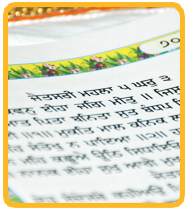Ghar 1 [Pehla (First)]: Each sentence (tuk) of the sabad, irrespective of number of ghars, is read/sung together, in order to comprehend the complete Gurmat message of the tuk. Based on number of tuks in a pada, Ghar 1 is of 13 sub-types. A pada of Ghar Pehla has up to 22 tuks.
Ghar 2 [Dooja (Second)]: There are two ghars in each sentence and both ghars are read/sung distinctly. Based on number of tuks in a pada, Ghar 1 is of 7 sub-types. A pada of Ghar Dooja has up to 20 tuks.
Ghar 3 [Teeja (Third)]: Each pada (stanza), has one, two or three tuks. If there is only one tuk in a pada, all three ghars are incorporated in the only tuk of the pada (depicted as 13). In case there are two tuks, then either there is one ghar in first tuk and two in the second (depicted as 1+2) or it could be otherwise i.e. two ghars in first tuk and one in second (depicted as 2+1). If there are three tuks in a pada, then every tuk shall contain one ghar each (depicted as 1+1+1). A pada of Ghar 3 can have no more than three tuks.
Ghar 4 [Chautha (Fourth)]: Each pada has either one, two or four tuks. If there is one tuk, then there are four ghars in such a tuk of pada. However, if there are two tuks in a pada, then there are either two ghars in each tuk (depicted as 2+2), or there is one ghar in first tuk and three in second (depicted as 1+3) or three ghars in first tuk and one in second (i.e. 3+1). In case of four tuks in a pada, every tuk comprises of a ghar in each tuk (depicted as 1+1+1+1). A pada of Ghar 4 can, thus, have up to four tuks.
Ghar 5 [Panjvan (Fifth)]: Each pada constitutes of one, two, three, four or five tuks. If there is one tuk in a pada, all five ghars are present in the only tuk in the pada (i.e. 15). The two tuks in a pada comprise of 2+3, 3+2, 4+1 or 1+4 ghars. If there are three tuks in a pada, they constitute of 1+2+2 or 2+2+1 or 1+1+3 or 2+1+2 ghars. If there are four tuks, they constitute of 1+2+1+1 ghars. In case there are five tuks in a pada, every tuk comprises of one ghar each (i.e. 1+1+1+1+1). A pada of Ghar 5 can have up to five tuks.
Ghar 6 [Chevan (Sixth)]: Each pada constitutes of one, two, three, four and six tuks. If there is one tuk in a pada, all six ghars are in the only tuk in the pada (i.e. 16). The two tuks in a pada comprise of 3+3, 2+4 or 4+2 ghars. If there are three tuks in a pada, they constitute of 1+1+4 or 2+2+2 or 3+2+1 ghars. If there are four tuks in a pada, they constitute of 1+1+2+2 or 1+2+1+2 or 2+2+1+1 or 2+1+1+2 ghars. In case there are six tuks in a pada, every tuk comprises of one ghar each (i.e. 1+1+1+1+1+1). A pada of Ghar 6 can have up to six tuks.
Ghar 7 [Satvan (Seventh)]: Each pada constitutes of one, two, three, four, five and six tuks. If there is one tuk in a pada, all seven ghars are in the only tuk in the pada (i.e. 17). The two tuks in a pada comprise of 3+4, 4+3 or 5+2 ghars. If there are three tuks in a pada, they constitute of 3+2+2 or 2+2+3 ghars. If there are four tuks in a pada, they constitute of 2+2+1+2 ghars. If there are five tuks in a pada, they constitute of 1+1+1+1+3 or 3+1+1+1+1 ghars. If there are six tuks in a pada, they constitute of 1+1+1+1+1+2 or 2+1+1+1+1+1 ghars. A pada of Ghar 7 can have up to six tuks.
Ghar 8 [Athhvan (Eighth)]: Each pada constitutes of two, four, six and eight tuks. The two tuks in a pada comprise of 4+4 ghars. If there are four tuks in a pada, they constitute of 3+2+2+1 ghars. If there are six tuks in a pada, they constitute of 1+1+1+1+1+3 ghars. If there are eight tuks in a pada, they constitute 1+1+1+1+1+1+1+1 ghars. A pada of Ghar 8 can have up to eight tuks.
Ghar 9 [Navan (Ninth)]: Each pada constitutes of two, three, four and eight tuks. The two tuks in a pada comprise of 3+6 or 6+3 or 4+5 or 5+4 ghars. If there are three tuks in a pada, they constitute of 3+3+3 or 4+2+3 or 5+1+3 ghars. If there are four tuks in a pada, they constitute of 3+2+2+2 ghars. If there are eight tuks in a pada, they constitute of 1+1+1+1+1+1+1+2 ghars. A pada of Ghar 9 can have up to eight tuks.
Ghar 10 [Dasvan (Tenth)]: Each pada constitutes of six tuks. A pada, constitutes of ten ghars in fifteen different ways.
Ghar 11 [Giarhvan (Eleventh)]: Each pada constitutes only of two tuks. There are two ways in Sri Guru Granth Sahib in which eleven ghars are comprised of in the two tuks of pada i.e. 5+6 and 6+5. A pada of Ghar 11 has up to two tuks.
Ghar 12 [Bahrvan (Twelfth)]: Each pada constitutes of four, six and eight tuks. The four tuks in a pada comprise of 3+3+3+3 ghars. If there are six tuks in a pada, they constitute of 2+2+2+2+2+2 ghars. If there are eight tuks in a pada, they comprise of twelve ghars as 2+1+1+1+1+2+2+2 ghars respectively in eight tuks. A pada of Ghar 12 can have up to eight tuks.
Ghar 13 [Tehravan (Thirteenth)]: Each pada constitutes of two, four, five and six tuks. The two tuks in a pada comprise of 8+5 ghars. If there are four tuks in a pada, they constitute of 2+5+2+4 ghars. If there are five tuks in a pada, they constitute of 3+3+3+2+2 or 5+3+1+2+2 ghars. If there are six tuks in a pada, they constitute of 3+2+2+2+2+2 ghars. A pada of Ghar 13 can have up to six tuks.
The discussion about Ghar 14 to Ghar 17 has been taken up separately.
There are 103 sub-types of Ghar of sabads described above. These sub-types are as under;
| Types of Ghar of Sabads | Sub-types of Ghar of Sabads |
| 1 | 10 |
| 2 | 11 |
| 3 | 4 |
| 4 | 5 |
| 5 | 11 |
| 6 | 12 |
| 7 | 11 |
| 8 | 5 |
| 9 | 9 |
| 10 | 15 |
| 11 | 2 |
| 12 | 3 |
| 13 | 5 |
| Total | 103 |








